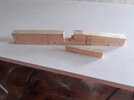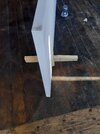The door frame is warped near the bottom of the lock side
I'm a bit confused. Could you clarify a couple of things for me - you said "door frame" at one point but the door is internal and there are architraves, so is it a rebated door casing (which would be 30 to 40mm thick), a door lining (which is basically flat 20 to 30mm thick with stop laths pinned or nailed in place) or a door frame (much heavier section timber, normally on outside doors, but not always, but in general these don't get used with architraves).
Normally you would eye down any timber you ard going to install looking for any crowning, bowing, cupping or winding (twist) before you fix it in place, rejecting the bad stuff. The same applies to doors, where you are mostly looking for cupping (across the width of the door) and winding. If you absolutely must install a warped door, use the straightest edge for the hinge side, but if your door is out by more than 3 or 4mm in the you will struggle to deal with it unless you are installing in a plain door lining with planted stops (see below)
If the problem is a warped door
frame, then they are pretty difficult to straighten, particulary twisted legs, and TBH replacement is often cheaper than the effort involved.
If the problem is with a door
lining, the stop laths can generally be removed and refixed if needs be bent to match the shape of the door
If the problem is with a rebated door
casing and the warp in the door then ideally the architraves (heads and the agfected leg) need to be removed, the door hung in the opening, the lock side leg unscrewed, any foam cut out, the leg bent into position and refixed. Some compromise about how well the door fits may be necessary. After this the archis can be replaced. If you have already tiled, the silcone down the edge of the architraves will need to be knifed to get it off.
As an alternative you
may be able to deal with the warp by pulling one or other of the hinges out a bit and refixing (on the grounds that flaws the hinge side are less noticeable), but the limit forvthatbis about 2 or 3mm
As to altering a rebate by planing, do you have.a rebate plane and how good are you with hand tools? Yes, it is doable with a rebate plane (fillister rebate or bull nose rebate plane) with a good sharp wide chisel to finish into the corners, but is is a real pain to do and not the easiest thing to execute neatly. As before it is another job where no power tool is really suitable for the task
Personally I
wouldn't plane the rebates. Donthe hinge trick if you can (the old screw holes get drilled out, wooden dowels glued in and when the glue has set the plugs are chiselled flush). If that didn't work fully I'd then bite the bullet, remove the arc and bend the casing to fit the door. Messing around with rebates is one of those PIA jobs that you won't derive any satisfaction from (and if you do crack a couple of tiles, which you shouldn't do if you are careful, it will.probably still cost less than a rebate plane that you'll be lucky to use twice in your entire lifetime)



